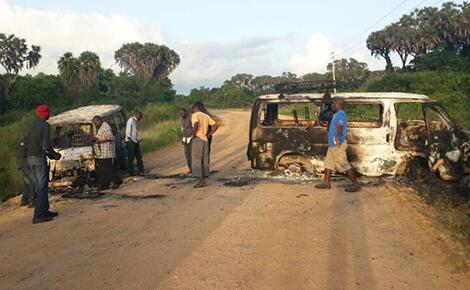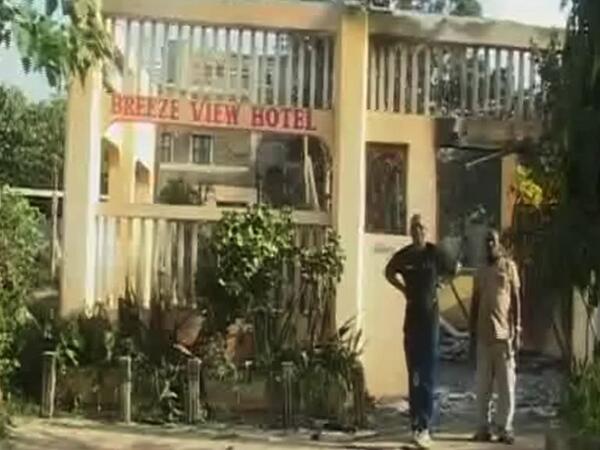[First of all, mkono wa tanzia kwa jamii, jamaa na marafiki wa waathiriwa wa maafa Mpeketoni jana usiku.The terrible tragedy
that unfolded in Mpeketoni, Lamu County on June 15, 2014 shocked millions of
Kenyans. But one of the few who was NOT surprised is the present writer, Onyango
Oloo. I am a senior writer with
Operation Firimbi Bulletin, a publication of the Mazingira Institute which
focuses on issues of land grabbing and campaigns against land grabbing and
corruption in Kenya. About four months ago, I traveled all the way to Lamu to
conduct research for issue number 37 of the Firimbi Bulletin. I reproduce below
an article I penned in March. I have
also included a link to the entire issue saved in PDF format. If you go through
article, you will see clearly why, even though I am traumatized and sad at the
wanton destruction of human life, I repeat, Onyango Oloo is NOT SURPRISED. In passing I must say it is laughable to see Interior Security cabinet secretary Joseph Ole Lenku showing up after 19 hours and link the Mpeketoni attack to the CORD rallies in general and Raila Odinga in particular. Does the Jubilee regime gets its security briefings from frothing nutbars on Twitter, Facebook and elsewhere on social media? ]
The
Ndovu (Elephant) in the Room
By Onyango Oloo, Senior
Writer, Operation Firimbi Bulletin
In
late February 2014, a member of the Operation
Firimbi Bulletin team had the opportunity of travelling all the way to Lamu
on a fact finding mission to see and hear first hand, the experiences,
struggles of the challenges of the people of Lamu as they grappled with myriad
challenges about historical injustices around land and their impact on matters
of cultural identity, survival of and
issues of equitable and sustainable national development, protection of the environment and the preservation of
world heritage sites.
Through
this breathtaking odyssey the themes of inter-community harmony, conflict
transformation, agrarian reform and new paradigms kept cropping and popping up.
Our
main host was the multi-member Save Lamu Coalition ensconced right in the
middle of Lamu, Kenya’s oldest urban area and a melting port of a range of
religions, races, ethnic groups and shared destinies.
Before
we got to the neighbourhoods of Witu, Mpeketoni, Hongwe, Morowe and Lamu Island
proper, however, we made a brief one day stop over in Malindi.
And
it was to meet the venerable scholar Professor
Abdulla Bujra, the long serving founder and Director of Development Policy Management
Forum, a development NGO which since its founding in 1995 has
carved a niche for itself for its cutting edge interventions in the spheres of
political economy, sustainable development, governance, environmental
protection and social justice. Prof. Abdalla Bujra was born in Malindi in 1938,
but spent most of his formative years in Lamu. He went to Lamu primary school,
Mombasa Secondary school then joined University of London where he did a BA in
African Studies and later obtained his Doctoral degree (PhD) in Sociology at
the School of Oriental and African Studies, University of London. As an
academic and scholar, Prof. Bujra has taught in various universities around the
world. His teaching expertise includes supervising senior researchers and
graduate students (PhD and MA) in academic institutions. He has also participated
in and managed several major high level Pan-African panels and committees
linked to the AU as well as Pan-African independent research organisations.
We
had actually planned to have an appointment with Prof. Bujra in Lamu, but when
we contacted him over the phone he informed us that he had come to Malindi on
other engagements. Since he had come highly recommended as a source on the
intricacies of the land and resourced based issues in Lamu we offered that we
could travel directly to Malindi from Mombasa and from there continue towards our rendezvous with the Coalition at
the archipelago up north.
The
good university don-now retired- happily obliged.
Our
first meeting was at the Jebreen Café, located ironically on Lamu Road in Malindi.
He later took us over to the offices of MEDA, a well known civil society
organization in the city which provided Vasco da Gama with his Kenyan pilot
five centuries ago.
In
our tête–à–tête with Prof. Bujra we were able to glean a lot of fascinating
tidbits about Lamu-its inhabitants, heritage and storied legacy.
The
professor did not disappoint when we zeroed in our main research interest: the
context of the land question in Lamu County.
“What you have in Lamu
is a question of internal colonialism. Lamu people, even though they are
Kenyans have long been treated as second class citizens in their own country.
All the powerful government people- the PCs, the DCs, the DOs all the powerful
public officers, especially those handling land matters have never been local,
they all come from Nairobi. Land in Lamu was declared government land, unlike
other areas of Kenya. Most Lamu peasant and small farmers do not have title
deeds. And then the ultimate monstrosity: in the 1970s, Mzee Jomo Kenyatta
opted to tackle the burning land question in Central Province by importing
thousands of Agikuyu into Lamu, creating the Lake Kenyatta Settlement scheme in
what is today Lamu West This was done in total disregard to the interests of
the Bajuni, Swahili, Orma, Awer and other indigenous Lamu people, many of whom
had been evicted from their ancestral land earlier. Jomo Kenyatta and his
acolytes like the former Coast PC were in power when local, politically
connected elites from Nairobi grabbed a lot of land in Lamu County. All these
issues planted the seeds of simmering conflict that will explode in the region
if local grievances are not dealt with.”
Professor
Bujra gave me the name of Abubakar
El-Amudy and other members of the Save
Lamu Coalition and advised me to make a point of meeting him and other
members of the coalition. He also gave me valuable references to important
documents and recommended I meet a range of contacts-not only in Lamu but also
in Nairobi, especially the Katiba Institute. He insisted that I must see for
myself Kililani, one of the proposed sites of the new port, and a scene of some
recent protests.
Since
this is NOT a glossy travelogue, to be read leisurely over a multi-time zone
transatlantic flight, I will suppress my almost uncontrollable urge to
construct a mental instagram , using adjectives, verbs and adverbs; I will
therefore skimp on the minutiae and skip
over the sun kissed, breezy, meandering odyssey to history drenched Lamu by sturdy country bus; of how we breath takingly, zippily traversed the oceanic
liquid expanse via steam boat-no, there was no time for bumpy, rickety, donkey rides on the ageless, narrow
lanes of the ancient, possibly enchanted town!
Upon arrival, Abubakar El-Amudy met me at the wharf and guided me to the squeaky clean guest
house that was to be domicile during my brief sojourn in Lamu.
A brief siesta on the humungous hand crafted
bed segued into my face to face with invited members of the Save Lamu Coalition
over at the second floor offices at the foot of downtown Lamu.
On hand for the meet, greet and round table
session were Mohamed Mbwana of the Shungwaya Welfare Association; Mohamed
Athman of the Lamu Marine Forum; Abubaker El Amudy himself of the Lamu
Environmental Coalition; and Chair of the coalition; Wahid Ahmed of the Lamu
Youth Alliance; Hussein Soud, the wise old man of Amu Council of Elders and
author of a good book on Swahili culture and Mohamed Athman Khatib, the
Coordinator of Save Lamu Coalition.
The
gathering with the usual warm Swahili hospitality that I have come accustomed
to having grown up in Mombasa from my
early teens welcomed me with tea and bitings and then fed me with a treasure of
information about Lamu; especially about LAPSSET and details of how the people
of Lamu were actually the first IDPs in post-colonial Kenya when Mzee
Kenyatta’s regime used a ruse about a Shifta presence to force many local
residents of Lamu to flee their burning, looted and pillaged homes for refuge
in Malindi, Mombasa and even as far as Tanzania. They amplified what Prof.
Bujra had recounted a day earlier about central government mandarins from
Nairobi lording it over the residents of Lamu; of the corruption and land
grabbing; of a sense of cultural and ethnic siege…
There
was a very robust and frank discussion about the settlement schemes around
Mpeketoni, Hongwe and elsewhere in Lamu West. There were echoes of what Bujra
had mentioned earlier about a déjà vu
sense of cultural invasion, in terms eerily reminiscent of passages from Ngugi
wa Thiong’o of European colonial settlements in the so called “White
Highlands”-complete with the sense of cultural alienation and near
annihilation. I was slightly startled at the intensity of the feelings
expressed but when one of the participants boldly and baldy foretold a coming
conflagration in Lamu over land with overtones of ethnic enmity, I had my eyes
wide open, taking furious notes as he went on to warn that if left unchecked
what may end up unfolding in Lamu may make the post-election violent skirmishes
in the former Rift Valley appear like child play.
When
I pressed on, playing devil’s advocate to tease out the details I uncovered
that the elephant in Lamu was the huge influx of Gikuyu migrants and settlers
making Mpeketoni what some locals considered a second GEMA homeland. As raw and as uncomfortable and as politically
incorrect the conversation unfolded it is clear that there is a lot of seething
rage in Lamu today over the unresolved land issues in contemporary Lamu and the
continued influx of Kenyans who are considered “outsiders” from up country into
the archipelago.
“We Lamu and Coastal
people have for centuries welcomed and embraced visitors into our midst. Many
people have come to Lamu, Mokowe, Hongwe, Mpeketoni, Manda-you name it. Some
have become Muslim; intermarried, made Lamu their home, speak in the Amu
dialect- you cannot tell they came from Kirinyaga, Machakos, Meru, Kisumu,
Bungoma. They have become part of us;
they are our neighbours our friends. But how do you go to someone’s home; grab
their land; kick them out; bring your own family members, recreate and rename
the neighbourhoods after your own villages up country. On top of that you come
into the local elections and attempt to usurp power! A significant percentage
of the ward representatives of the Lamu
County Assembly are from one ethnic group! The Member of the National Assembly
is called Ndegwa for crying out loud! Be
more respectful of us! At least give us the courtesy to run the affairs of our
own county! Already only two tribes are dominating the national government!
Can’t the Lamu people govern Lamu? We fear that this LAPSSET project which
requires a population of one million will make us, the indigenous people of
Lamu, lose our cultural, religious and ethnic identity forever. We are only
100,000 right now in the whole of Lamu!”
Very
sobering thoughts.
Click on the link below for the entire issue of Firimbi # 37 saved in PDF format:
http://www.mazinst.org/files/mazpub/Firimbi%20Bulletin%20No%2037.pdf










